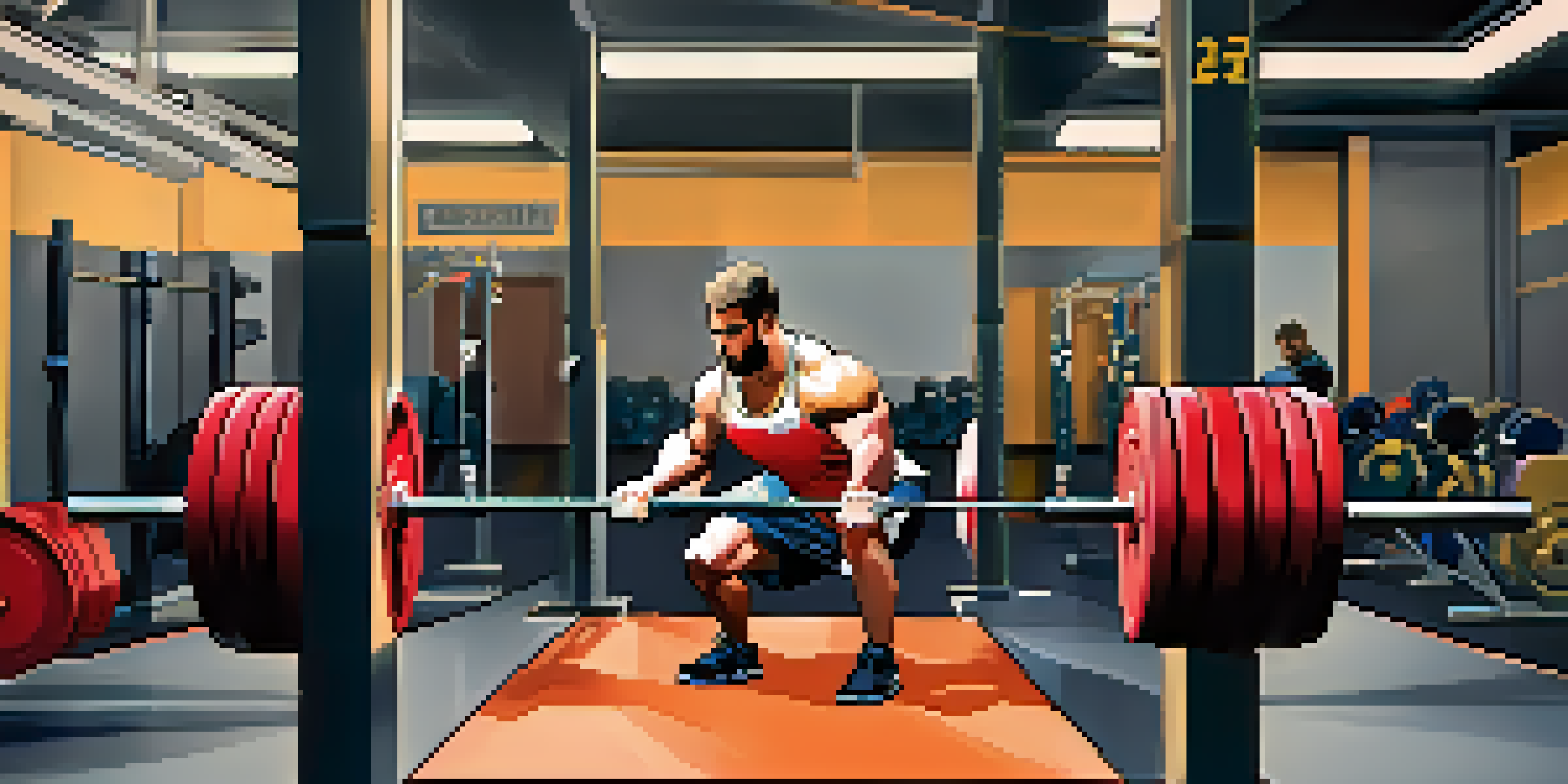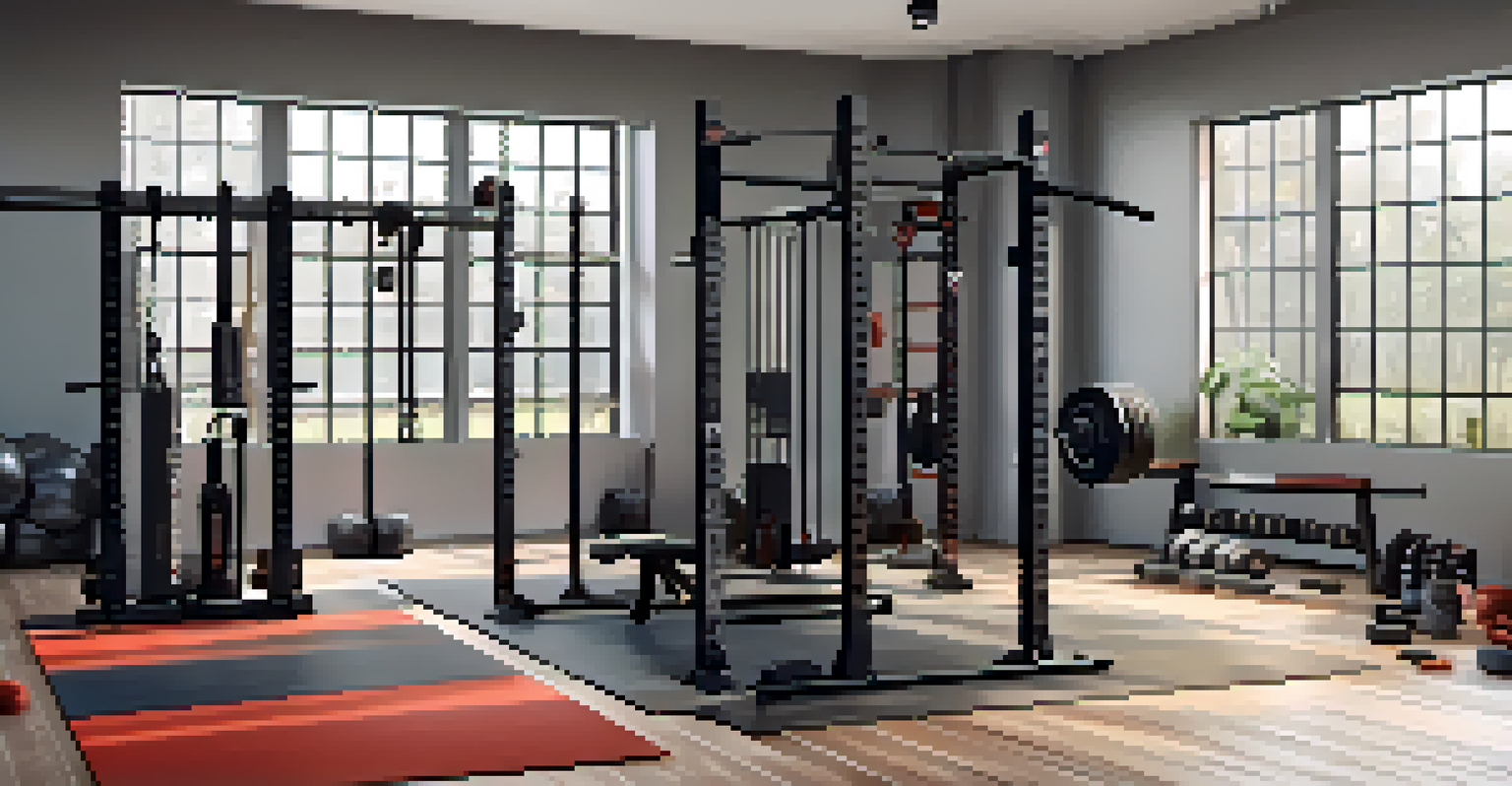Understanding Powerlifting Safety Protocols for Beginners

Importance of Safety in Powerlifting for Beginners
Starting powerlifting can be exhilarating, but safety should always be your top priority. Beginners often underestimate the risks associated with lifting heavy weights, which can lead to serious injuries. Understanding the fundamentals of safety will not only enhance your lifting experience but also promote a lifelong passion for the sport.
Safety isn't just a tagline, it's a way of life.
In powerlifting, you're not just lifting weights; you're challenging your body. This means that implementing safety protocols can make a significant difference in how effectively you train. By prioritizing safety, you're setting a solid foundation that will allow you to progress without setbacks.
Moreover, a strong focus on safety instills confidence in your abilities. When you know you're following best practices, you can concentrate on your form and technique rather than worrying about potential injuries. This peace of mind can empower you to push your limits responsibly.
Essential Gear for Safe Powerlifting Training
The right gear is crucial for ensuring safety in powerlifting. Items like weightlifting shoes, belts, and knee sleeves can provide the support and stability you need while lifting. Investing in quality equipment designed for powerlifting can help prevent injuries and enhance your performance.

Weightlifting shoes, for instance, provide a solid base and help maintain proper posture during lifts. Similarly, a lifting belt can support your lower back, especially during heavy lifts like squats and deadlifts. Knee sleeves can offer compression and warmth, protecting your joints during intense training sessions.
Safety is Crucial for Beginners
Prioritizing safety in powerlifting helps prevent injuries and fosters a positive training experience.
While it might be tempting to skip these accessories, remember that they play a vital role in your safety. Just like a seatbelt protects you in a car, the right gear safeguards your body while lifting, allowing you to focus on your technique and strength development.
Learning Proper Form and Technique
Before you start lifting heavy, it’s essential to learn the correct form for each exercise. Poor technique not only reduces the effectiveness of your workout but also increases the risk of injury. Take the time to master each movement, starting with lighter weights.
The only bad workout is the one that didn't happen, but safety should always come first.
Consider working with a coach or experienced lifter who can guide you through the basics. They can provide valuable feedback on your form, helping you make necessary adjustments early on. This mentorship can be instrumental in your powerlifting journey and can make training much more enjoyable.
Practicing proper form also builds muscle memory, which is crucial when you start increasing weights. As you become more comfortable with the techniques, you'll find that lifting feels more natural, allowing you to focus on your progress rather than worrying about injuries.
The Role of Spotters in Powerlifting
Having a spotter is a critical safety measure that every beginner should embrace. Spotters are trained to assist lifters during heavy lifts, providing that extra layer of security and confidence. Whether you're bench pressing or squatting, a spotter can help you lift safely and effectively.
It's important to communicate with your spotter before each lift. Make sure they understand your goals and how much weight you're lifting. Establishing a signal for when you need assistance can also streamline the process and ensure both of you are on the same page.
Proper Gear Enhances Safety
Investing in quality powerlifting gear like shoes, belts, and knee sleeves provides essential support and stability.
Remember, a good spotter will not only help you lift safely but also contribute to your overall training experience. They can encourage you and provide feedback, making each session more productive and enjoyable. So, don’t hesitate to ask for help when you need it!
Warm-Up and Cool-Down Practices
Warming up and cooling down are vital components of any powerlifting routine. A proper warm-up prepares your muscles and joints for the strain of lifting heavy weights. Activities like dynamic stretching and light cardio can help increase blood flow and decrease the risk of injury.
On the flip side, cooling down helps your body transition back to its resting state. Incorporating static stretching and light movements after your workout can aid in recovery and reduce muscle soreness. This practice not only promotes flexibility but also contributes to long-term performance improvements.
Ultimately, neglecting these practices can hinder your progress and lead to injuries. By dedicating time to warm up and cool down, you’re investing in your body’s health, ensuring that you can continue pursuing powerlifting for years to come.
Recognizing Signs of Fatigue and Injury
As a beginner, it's crucial to listen to your body and recognize the signs of fatigue and injury. Pushing through pain can lead to serious consequences, so understanding how to differentiate between discomfort and injury is essential. Always stay attuned to how your body feels during and after workouts.
If you experience persistent pain or unusual fatigue, it's important to take a step back. Ignoring these signals can turn minor issues into major injuries, jeopardizing your powerlifting journey. Don’t hesitate to consult a healthcare professional if you’re unsure about any symptoms.
Learn Form to Avoid Injuries
Mastering correct lifting technique is vital for effectiveness and injury prevention, making coaching beneficial.
Learning to respect your body’s limits is a key part of becoming a successful lifter. By acknowledging when to take breaks or adjust your routine, you’re ensuring that your powerlifting experience remains positive and sustainable.
Creating a Safe Training Environment
A safe training environment is fundamental to your success in powerlifting. Whether you're at a gym or lifting at home, ensure that your space is free of hazards that could lead to accidents. Keep the area tidy and organized, and make sure you have ample room to perform lifts safely.
If you're training at a gym, familiarize yourself with the equipment and layout. This knowledge will help you navigate the space more confidently and avoid potential mishaps. Additionally, be aware of your surroundings; knowing when others are lifting nearby can prevent collisions or distractions.

At home, invest in sturdy equipment and proper flooring to create a safer lifting environment. By taking these precautions, you’ll not only enhance your safety but also improve your focus and performance when training.